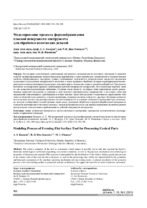| dc.contributor.author | Козерук, А. С. | |
| dc.contributor.author | Диас Гонсалес, Р. О. | |
| dc.contributor.author | Филонова, М. И. | |
| dc.coverage.spatial | Минск | ru |
| dc.date.accessioned | 2020-12-01T10:20:05Z | |
| dc.date.available | 2020-12-01T10:20:05Z | |
| dc.date.issued | 2020 | |
| dc.identifier.citation | Козерук, А. С. Моделирование процесса формообразования плоской поверхности инструмента для обработки конических деталей = Modeling Process of Forming Flat Surface Tool for Processing Conical Parts / А. С. Козерук, Р. О. Диас Гонсалес, М. И. Филонова // Наука и техника. – 2020. – № 6. – С. 492-498. | ru |
| dc.identifier.uri | https://rep.bntu.by/handle/data/82009 | |
| dc.description.abstract | Рассмотрено относительное срабатывание инструмента, позволяющее не учитывать зависящие от внешних условий трудноопределяемые технологические коэффициенты, а также физические, механические и технологические свойства обрабатываемого материала. Данное срабатывание определяется распределением скоростей скольжения и давления в зоне контакта инструмента и заготовки, а также временем обработки, которые характеризуются геометрическими и кинематическими параметрами исполнительного механизма станка и режимами обработки. Предложено поэтапное моделирование процесса срабатывания рабочей поверхности инструмента: без осцилляции верхнего звена и с его возвратно-вращательным движением. Согласно этому подходу, на первом этапе выполняется расчет распределения скоростей скольжения и давления в зоне контакта притирающихся поверхностей, а на втором этапе при определении относительного срабатывания в точках нижнего звена (инструмента) отслеживается перемещение этих точек из областей зоны контакта с одними значениями указанных величин в области с другими. Получена математическая модель процесса формообразования плоской поверхности в условиях свободного притирания тела и контртела, которая устанавливает количественные связи между режимами обработки и формой обработанной поверхности и является имитационной численной моделью, так как позволяет получать для наперед выбранных моментов времени распределение относительного срабатывания по рабочей поверхности инструмента. | ru |
| dc.language.iso | ru | ru |
| dc.publisher | БНТУ | ru |
| dc.title | Моделирование процесса формообразования плоской поверхности инструмента для обработки конических деталей | ru |
| dc.title.alternative | Modeling Process of Forming Flat Surface Tool for Processing Conical Parts | ru |
| dc.type | Article | ru |
| dc.identifier.doi | 10.21122/2227-1031-2020-19-6-492-498 | |
| local.description.annotation | The relative actuation of the tool is considered, which makes it possible not to take into account the hard-todetermine technological coefficients depending on external conditions, as well as the physical, mechanical and technological properties of the processed material. This response is determined by the distribution of the relative sliding speeds and pressure in the contact zone of the tool and the work-piece, as well as the processing time, which are characterized by the geometric and kinematic parameters of the machine operating mechanism and processing modes. A phased simulation of the actuation process of the tool working surface is proposed: without oscillation of the upper link and with its return-rotational movement. According to this approach, at the first stage, the distribution of the relative sliding speeds and pressure in the contact zone of the grinding surfaces is calculated, and at the second stage, when determining the relative response at the points of the lower link (tool), the movement of these points from the areas of the contact zone with same values of the indicated quantities in the area with others is monitored. A mathematical model of the process of shaping a flat surface under conditions of free grinding of the body and counter-body is obtained, which establishes quantitative relationships between the machining modes and the shape of the treated surface and is a simulation numerical model, since it allows to obtain the distribution of relative triggering over the working surface of the tool for pre-selected time points. | ru |

